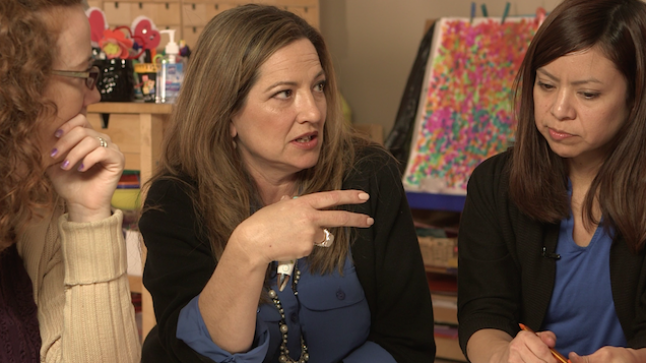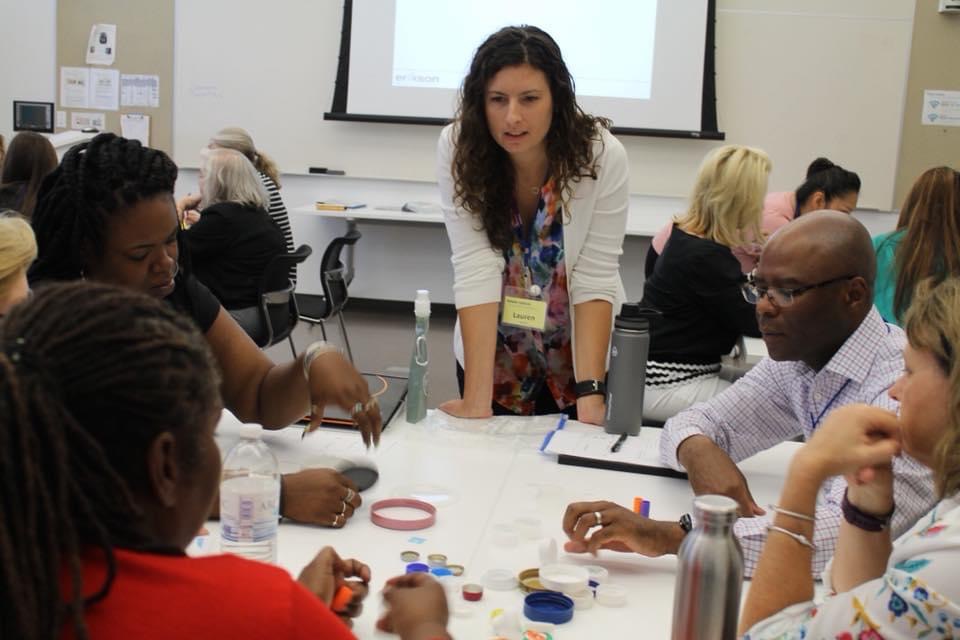Series: Adult Learning
4 Key Findings for Early Childhood Coaching Strategies with Teachers

Instructional coaching is central to the Collaborative’s professional development efforts. There is a lot to learn from what works and what doesn’t when it comes to early childhood coaching strategies, particularly when focused on the teaching of early mathematics. Lauren Solarski’s recent dissertation, “Clarifying Coaching: A Mixed Methods Analysis of a Math Content-focused Model and Its Impact on Teachers’ Practice, Content Knowledge, and Dispositions” sheds light on the topic.
Lauren Solarski first came to know the Early Math Collaborative through our partnership with Big Shoulders Fund. As a kindergarten teacher, she was inspired by the Big Ideas and motivated to come study at Erikson Institute. While earning her doctorate, Solarski also worked as an early math coach with the Collaborative. This informed her work dissecting what early math coaching entails, what we have learned from our coaching model, and what the research says.
Coaching is complex, and it looks different in different settings. “Research is still at the point of defining what coaching is,” says Solarski. Yet, there are key findings to consider when developing early childhood coaching strategies for teachers.

1. The Importance of Planning
Coaches and teachers planning together seems to be an important component of coaching. “Overall,” Solarski says, “published studies are not always clear about the components of coaching.” But most instructional coaching tends to involve an observation of the teacher, and most involves a reflection of that observation afterwards. One thing it doesn’t always include is a coach’s involvement with the planning of the activity or lesson. Solarski thinks that is a missed opportunity.
“If something doesn’t work with students,” she says, “the coach and teacher both have ownership over that and therefore the problem solving in the reflecting conversation becomes truly collaborative. Planning together also allows for some of the logistics such as materials, number of students, and location in the classroom to get taken care of up-front so that the reflecting conversation can really get to what teachers and students said and did.”
Being a part of the planning means that coaches are more involved with the learning process of the teacher. This can be just as important as seeing the learning of the children take place in the classroom.
Planning becomes especially important in content-focused coaching models to ensure that teachers understand the new knowledge they are acquiring and how to integrate it with children. My study found that teachers were still processing what they learned in the workshops with their coaches during planning since the new information is complex.
2. Role-Playing is a Useful Tool
Another key component Solarski found in her study: role-playing. It often isn’t enough to just say what you are going to do. It is bound to be a bit different when teachers are in the classroom with children.
“Actually embodying the words and actions,” she says, “allows teachers to further internalize new knowledge about math teaching. In my study, participants attributed their increased confidence in math teaching to role-play.”
Acting out how the lesson will go has all sorts of benefits, including creating a safe space for educators to think through the lesson without the curve balls that the children might throw during the lesson or activity. The teachers practice how to respond to questions, confusions, and students’ own ideas.
“Teachers rehearse how they will introduce the activity with children,” she describes. “They scaffold children’s thinking, and then conclude the lesson. It’s also an opportunity to explore the lesson materials such as game pieces or collections for sorting. One teacher pretends to be the lead while the other teacher(s) and coach act as students. This allows them to anticipate how children might engage with the Big Ideas or math concepts that are the lesson’s focus.”
3. Teaching Assistants Can Play a Pivotal Role
Teacher assistants are sometimes overlooked as instructional resources. For example, in classrooms with monolingual teachers, it is often the teacher assistant who shares the children’s home language and who provides language support during math. Yet, they aren’t always part of coaching nearly as much as they should be.
“Most of the literature from K-12 assumes coaching is a one-on-one relationship,” Solarski says. “But in early childhood settings that have multiple adults working together in the same classroom, my study’s findings highlight the importance of a group coaching format that is inclusive of lead and assistant teachers and promotes collaboration.”
There are plenty of pitfalls when teachers and teacher assistants don’t have the same benefits of the coaching process and knowledge that is shared during it.
It is important – particularly in early math – for teachers to have a unified understanding. For example, one goal of the intervention that is based on research is to get children to deepen their conceptual understanding of numbers 1-5 and the relationships between them, rather than the common approach to have children memorize and recite the number sequence to 100. If an assistant teacher is denied the opportunity to participate in coaching there may be a disconnect, and they might even think their co-teacher isn’t challenging the children enough. There could be tension and ultimately confusion for the children.
4. Confidence and Attitudes of the Teachers Matter
Addressing the mathematical mindset of teachers is critical, and the Collaborative is clear about the importance of teachers’ attitudes and beliefs when it comes to teaching math. Solarski’s study confirms this emphasis.
“Confidence and attitudes are important in the context of early childhood mathematics,” Solarski says, “because early childhood teachers report high levels of math anxiety and negative experiences around math in their own schooling histories. These can negatively impact their work with children.”
Shifting mindsets can also be seen as the part of coaching that creates the most opportunity. It can be difficult to increase comfort with mathematics in a workshop or online session with many educators hearing the same thing. A coaching process that delves into diverse early childhood coaching strategies gives each individual teacher a voice with a knowledgeable other. It gives them an ability to be themselves, with whatever educational history and backgrounds they may have.
Just as education has trended towards thinking about the “whole child,” a coaching process can help schools think more about the whole teacher.
“I think it’s important that interventions consider teachers as whole persons and not just vessels to deliver student learning.”